Abstract
The UML model of a land and building cadastre is defined in current Polish legal regulations. Its main part is the UML application schema that defines relationships between the main cadastral objects in sixteen diagrams. These objects—cadastral parcels, buildings and (independent) premises—are essentially 2D objects. Their relationships with other cadastral objects are compared and analysed in this paper. The UML model is built to supplement the application scheme of the traditional cadastral model with three new objects that are the equivalents of the main cadastral objects in 3D: ‘Cadastral Parcel 3D’, ‘Building Legal Space 3D’ and ‘Premises 3D’. Although the first two have been defined in earlier publications, this paper defines ‘Premises 3D’. Objects such as ‘Building Common Part 3D’ and ‘Building Part of Non-Extracted Premises 3D’ are proposed. The relationships among new 3D cadastral objects and objects of traditional cadastre are presented in three new diagrams. The authors propose that these new diagrams are added to the current cadastral model. It could be the foundation for building a future 3D cadastral model in Poland. In the authors’ opinion, the applied methodology may also be used in various legal systems.
1. Introduction
Works on a three-dimensional (3D) cadastre have been discussed since 2001 when a workshop on this subject was held in Delft, the Netherlands [1]. As acknowledged later, it was premature to raise this topic due to various organisational, legal and technological conditions.
Since then, the development of 3D cadastres has become an ever more popular matter, determined by two main factors. In 2010, the Joint Commission 3 and 7 Working Group on 3D Cadastres was established by the International Federation of Surveyors (FIG). A questionnaire on the probable future development of 3D cadastres was prepared, published and completed by professionals from various countries. A summary of its results is presented in [2].
The results of the questionnaire have aroused controversies in different places, including Poland. As its authors later admitted, it was sometimes difficult to understand the ambiguous vocabulary used, and problems with precise answers and their proper interpretation appeared.
Since then, two similar surveys have been conducted (in 2014 [3] and 2018 [4]) and completed by representatives from many countries. These questionnaires took into account the development of both theory and practice in the broadly defined domain of 3D cadastres. The literature concerning this field has been gathered and presented on the website of the FIG Joint Commission 3 and 7 Working Group on 3D Cadastres [5].
The model for describing the registration systems of widely understood space is provided by the ISO 19152 standard ‘Geographic Information—Land Administration Domain Model (LADM)’ [6]. According to ISO 19152, a spatial unit may be a single area (or multiple areas) of land and/or water or a single volume (or multiple volumes) of space. The 3D spatial unit can be part of space above or below the earth’s surface.
Open Geospatial Consortium is developing, inter alia, two standards: City Geography Markup Language (CityGML) and the Land and Infrastructure Conceptual Model (LandInfra). BuildingSMART is working on Industry Foundation Classes (IFC). According to [7], these standards encompass many of the spatial scales and concepts necessary for modelling the built environment:
- IFC is used predominantly for the exchange of rich, fine-scale building and infrastructure data in the AEC industry.
- CityGML is a schema for interoperability and structuring urban data.
- LandInfra has been introduced more recently to enable the modelling of land and civil engineering infrastructure facilities.
A comparative analysis of these three standards is presented in [8]. The 3D cadastre (3D Digital management of property interests in the building complexes), one of the use cases that can possibly benefit from BIM-GIS integration through LandInfra, is provided as an example.
It is difficult to describe all aspects of 3D cadastral issues. The authors decided to present only the latest research on this subject and focus on a variety of specific aspects regarding 3D cadastral issues. The proposal to introduce the term 3D Land Administration for 3D land uses so that it has a wider and more universal meaning [9] appears to have attracted a lot of interest and is currently an increasingly popular idea. Another important issue from the cadastral point of view also seems to be the Spatial Development Lifecycle in 3D Land Administration [10].
Some research concerns surveying works. These involve the application of LiDAR for densely built areas [11] or crowd-sourced cadastral surveys [12]. Important issues relating to 3D cadastres include applications of the ‘Land Administration Domain Model’ in various 3D cadastral aspects, such as the development of 3D spatial profiles to support the full lifecycle of 3D objects [13]; 3D data in the ISO 19152 valuation model [14]; the LADM-compliant 3D cadastral prototype system [15]; the spatial planning information package in ISO 19152 [16]; and LADM-IndoorGML for exploring user movements in evacuation exercises [17]. An interesting example of cadastral data use as a source for 3D indoor modelling is described in [18], whereas the simulation of a large-scale 3D cadastral dataset using procedural modelling is presented in [19].
The level of land administration (particularly cadastres) development varies between each country. Therefore, a lot of work is being done on the current problems that these countries or jurisdictions encounter. The status and potential for land administration and management in the context of the possible development of 3D cadastres in India are examined in [20], whereas research on the environmental impact of 3D public law restrictions in Greece is described in [21]. Initial registration of the 3D cadastre by a cadastral resurvey in the Republic of Croatia and works to bring the Real Property Cadastre closer to a real 3D register are presented in [22]. The conversion of 2D analogue cadastral boundary plans into 3D digital information and visualisation in Stockholm, Sweden is described in [23]. The application of cadastral data in the registration of apartments is presented in [24]. An analysis to determine the degree of proximity of the cadastral systems to the 3D cadastral model in Ecuador is presented in [25]. The issue of using BIM data with the application of BuildingSMART’s Industry Foundation Classes (IFC) in the context of input data to the 3D cadastre is described in [26]. Works with the open Building Information Modelling (BIM) standard to source legal spaces for 3D cadastre are studied in [27], whereas the use of BIM and GIS for the representation and visualisation of a 3D cadastre is described in [28]. An interesting case for the development of the process model for a Serbian cadastre applying BuildingSMART’s open BIM IFC standard is described in [29]. An important aspect of 3D cadastral data validation using the example of Victoria, Australia is presented in [30]. Last but not least, when the authors include the time factor, the context of a 4D cadastre appears, such as in research that has been carried out concerning the modelling of legal land objects for water bodies [31].
The number of research projects regarding 3D cadastre or 3D land administration is growing. In the authors’ opinion, there are many problems awaiting solutions, and new challenges are frequently appearing. Therefore, the aim of this paper is to systematise the most important issues related to the 3D cadastre and present conceptual works concerning the further construction of its universal model. However, due to the fact that there are many different views on this issue in the worldwide literature, the authors propose certain solutions based on and originating from the Polish legal system.
2. Methodology and Materials
The 3D cadastral model proposed in this paper was created on the basis of the existing 2D cadastral model in Poland. The presented conceptual work began with an analysis of the legal basis and selected elements of the Polish cadastre. The analysis focused on records concerning the structure of the database containing information on the land, buildings and premises, which are included in the Law on Geodesy and Cartography [32] and the regulation concerning the Land and Building Cadastre [33]. The research has also been extended to include literature analysis on 3D cadastres. Next, an attempt was made to standardise the provisions of Polish law in order to harmonise the developed solutions with global solutions, and the authors’ own 3D cadastral model was proposed. The research scheme is presented in Figure 1.

Figure 1.
Scheme of conceptual work on the construction of the 3D cadastre model.
3. The Cadastre and Its Development in Poland
Information on real estate in Poland is recorded in two independent systems, which are the land and building cadastre and land and mortgage register [34]. The legal basis of the former is the Law on Geodesy and Cartography [32] and the regulation concerning the Land and Building Cadastre [33]. The land and mortgage register operates on the basis of the Act on Land Register and Mortgage [35]. Although all these normative acts were created at a time when full digital information about real estate remained in the sphere of more or less realistic concepts of the future, they are quite well adapted to the current realities. We owe this state of affairs to the ongoing changes [36]. The most notable of them occurred, of course, after the implementation of the INSPIRE Directive [37], which made it necessary to create a conceptual model for Polish cadastral data [38,39]. This model was introduced to the regulation on Land and Building Cadastre with the amendment of 2013 [40]. It includes the UML application schema, cadastre objects’ catalogue and GML application schema for the cadastral data. In the objects catalogue, 71 classes were defined (divided into 8 thematic packages), which were necessary to create the UML application schema. The scheme consists of 16 diagrams [41].
In accordance with the current definition of the land and building cadastre, it shall ensure that information on all cadastral objects—land, buildings and premises—which are separate properties, as well as their owners and other entities owning or managing these objects, is collected, updated and made available in a uniform manner throughout the country [32]. According to the Polish legal regulations, buildings and premises may be separate properties or may be part of another object. The building may be part of a land parcel and the premises may be part of a building. The information to be collected in the land and building cadastre primarily concerns their location in the orthogonal coordinate system, but the database also contains a number of attributes describing the physical and legal status of the cadastral objects [42]. The only reference to the three-dimensional space can be considered descriptive information on the number of underground and aboveground floors.
More or less since 2010, ideas about a 3D cadastre have gained widespread popularity in Poland. In 2010, a questionnaire on a 3D cadastre for Poland was completed within the activities of the FIG Joint Commission 3 and 7 Working Group on 3D Cadastres [43]. Such questionnaires were subsequently completed in the years 2014 [44] and 2018 [45].
Since then, much research concerning 3D cadastre has been conducted in Poland [46,47,48,49,50,51,52,53,54,55]. Their scope encompasses theory, practice or very often are the combination of both. The more detailed description of these studies is presented in [56].
4. Creating a 3D Cadastral Model for Poland
When analysing previous works concerning the cadastre in Poland (described in Section 3), we can obviously find that they go in various directions and therefore do not seem comprehensive. The authors’ idea is to continue to develop such research work to build a versatile model of the 3D cadastre for Poland, based on the current legal regulations [32,33].
The UML application schema for land and building cadastral data, which consists of 16 diagrams [33], was adopted as a starting point. Earlier works in this area [49,51,56] are also beneficial for this research.
The objects of the Polish land and building cadastre are land parcels, buildings and premises constituting an independent property. For the purpose of developing the UML model for the 3D cadastre, analyses of the relationships of the land parcel, building and premises with other objects were conducted. These relationships were developed on the basis of the UML model given in the regulation [33]. The application schemas are available as *.eap files at the Head Office of Geodesy and Cartography website [57].
The paper uses English names of land and building cadastral classes translated from Polish and listed, together with the mapping of LADM classes in [41]. The prefix ‘EGiB’ used in the names of classes comes from the Polish cadastre name Ewidencja Gruntów i Budynków.
Since the study is not the creation of a new model but only the enrichment of it with new 3D objects, it has been assumed that linkage to ISO 19152 will be done by mapping newly proposed classes with corresponding LADM classes. A table with names of the newly proposed classes and their mapping with LADM classes is presented at the end of the paper.
The starting point for creating the 3D cadastral model is an analysis of the relationships between the present cadastral objects: a cadastral parcel, building and premises with other objects. A cadastral parcel is a 2D object in the light of Polish legal regulations [58], whereas, physically, it is 2.5D (only one z coordinate for any x, y) or, in other words, it is a 3D surface. The 3D cadastral parcel concept is developed in this research and is based on a 2D parcel. The building and the premises are physically 3D objects; however, according to Polish law, they are generally described as 2D objects with only some references to the third dimension.
According to [33], a cadastral parcel is a continuous area of land located within a single cadastral section, legally homogenous and separated from its surroundings by boundary lines. In the UML model, ‘Cadastral Parcel’ is part of the ‘Cadastral Section’ and includes ‘Contour of Soil Quality Valuation in Parcel’. ‘Cadastral Parcel’ is linked by applying directed association with ‘Boundary Point’ and ‘Registered Unit of Land’ (navigability from ‘Cadastral Parcel’). ‘Cadastral Parcel’ is linked with ‘Building’ and ‘Lease’ (navigability to ‘Cadastral Parcel’). The relationships of the ‘Cadastral Parcel’ with cadastral objects were prepared and based on diagrams of the present cadastral model defined in [33] and are presented in Figure 2.
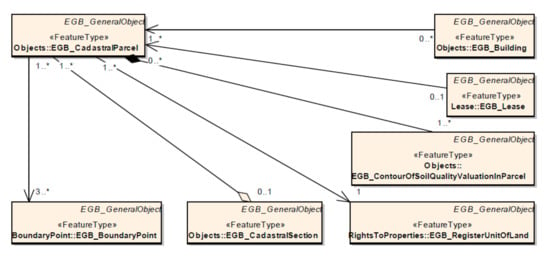
Figure 2.
The relationships between ‘EGB_CadastralParcel’ and other classes of the Polish cadastral model.
A building is a structure as defined by the Regulation of the Council of Ministers of 30 December 1999 on the Polish Classification of Construction Objects [59]. In the UML model, ‘Building’ is linked, applying directed association with ‘Cadastral Parcel’ and ‘Register Unit of Buildings’ (navigability from ‘Building’). ‘Building’ is linked with such objects as ‘Object Permanently Connected with Building’, ‘Register Unit of Premises’, ‘Lease’, ‘Premises’, ‘Chamber Belonging to Premises’ and ‘Building Block’ (navigability to ‘Building’). The relationships of ‘Building’ with cadastral objects are presented in Figure 3.
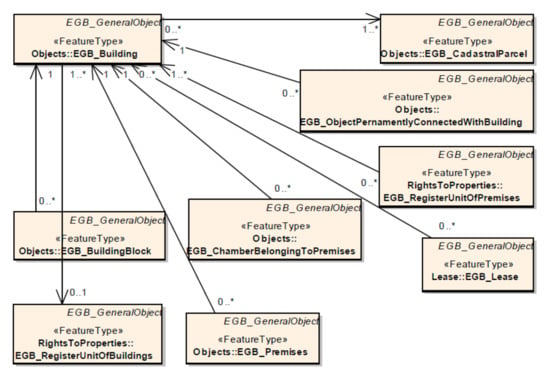
Figure 3.
The relationships between ‘EGB_Building’ and other classes of the Polish cadastral model.
The premises listed in the land and building cadastre are premises constituting an independent property according to the Act of 24 June 1994 on the ownership of premises [60]. ‘Premises’ in the UML model is linked by applying directed association with ‘Building’, ‘Chamber Belonging to Premises’, ‘Register Unit of Premises’ and ‘Address’ (navigability from ‘Premises’). ‘Premises’ is linked with ‘Lease’ (navigability to ‘Lease’). The relationships of ‘Premises’ with other cadastral objects are shown in Figure 4.
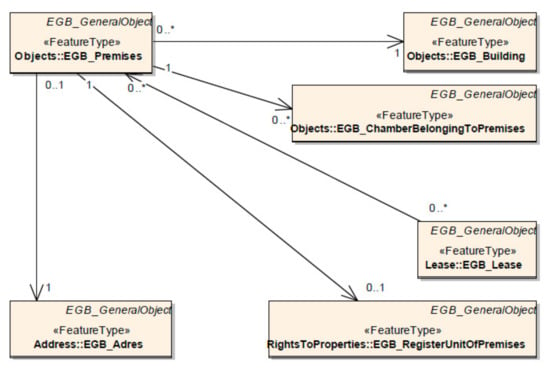
Figure 4.
The relationships between ‘EGB_Premises’ and other classes of the Polish cadastral model.
After the analysis and presentation of the relationships of ‘Cadastral Parcel’, ‘Building’ and ‘Premises’ with other cadastral objects, for the purpose of creating the UML model of a future 3D cadastre, considerations began regarding ‘Cadastral Parcel’ and ‘Building’. The relationships between the objects of the Polish cadastral model and the proposed 3D cadastral objects for building objects were investigated in earlier works [50,56]. It was decided to start creating a new diagram to investigate the relationships between ‘Cadastral Parcel’ and ‘Building’. According to Polish regulations, two cases are possible (Figure 5):
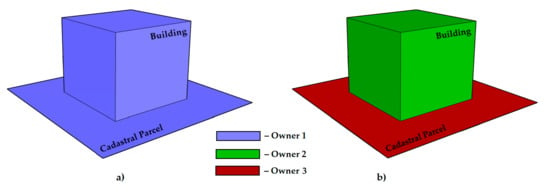
Figure 5.
The relationships between cadastral parcel and building. Illustration of physical objects: (a) Case 1; (b) Case 2.
For the purposes of the future 3D cadastre, it was proposed that in both cases, ‘Building Legal Space 3D’ should be part of ‘Cadastral Parcel 3D’. The relationships between ‘Cadastral Parcel’, ‘Cadastral Parcel 3D’ and both 2D and 3D building objects are shown in Figure 6.
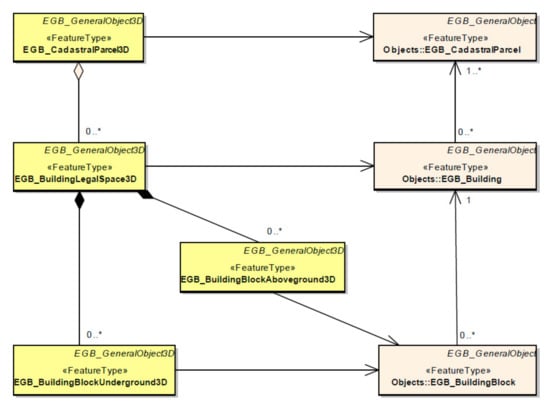
Figure 6.
Diagram of ‘Parcel3DBuilding3D’ defining the relationships between ‘Cadastral Parcel’, ‘Cadastral Parcel 3D’ and both 2D and 3D building objects.
The next and last object of the 2D cadastre, which the authors want to make truly a 3D cadastral object, is ‘Premises’ According to Polish law [60], it is very common that premises constitute independent properties within a building.
In the current system of land and building cadastre, ‘Premises’ is typically a 2D object. It does not contain spatial attributes. If a premises is not established as an independent property, the ownership of a premises does not differ from that of a building. If the premises is established as an independent property, then such a property includes the premises (apartment) itself, rooms belonging to the premises, a share in common parts of the building and a share in the parcel. The authors propose that when the premises is established as an independent property, a ‘Premises 3D’ object should be created simultaneously.
In the case of establishing independent premises in the building, ‘Building Legal Space 3D’ will not comprise ‘Building Block Aboveground 3D’ or ‘Building Block Underground 3D’. It will include ‘Premises 3D’, ‘Building Common Part 3D’ and ‘Building Part of Non-Extracted Premises 3D’ (Figure 7). ‘Building Common Part 3D’ is the space not intended for the exclusive use of the premises’ owners. It may comprise the staircase, lift, corridors and so on. ‘Building Part of Non-Extracted Premises 3D’ is the space that comprises all premises that have not been established as independent properties.
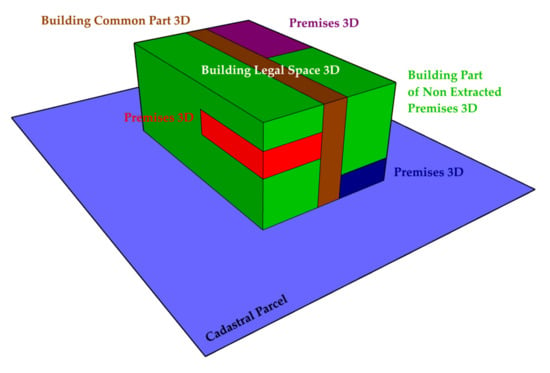
Figure 7.
‘Building Legal Space 3D’ including ‘Premises 3D’, ‘Building Common Part 3D’ and ‘Building Part of Non-Extracted Premises 3D’. Illustration of legal division.
The relationships of ‘Premises 3D’ with traditional cadastral objects and proposed 3D objects are shown in Figure 8.
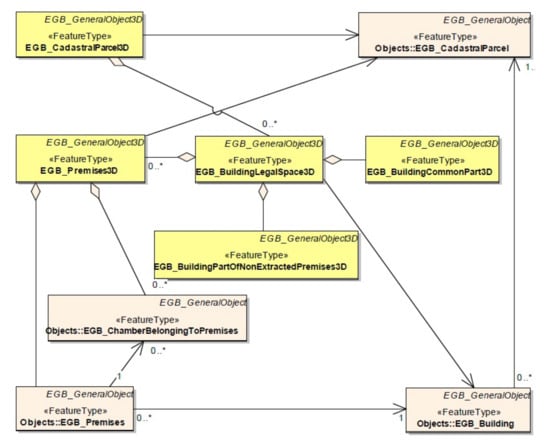
Figure 8.
Diagram of ‘Premises3D’ defining relationships between 3D premises with traditional cadastral objects and proposed 3D objects.
In the Polish cadastral model, all objects inherit attributes like ‘startObject’, ‘endObject’ or its versions and the identifier in the infrastructure of spatial information, from the ‘EGB_GeneralObject’ class. In this study, it was decided to create the class ‘EGB_GeneralObject3D’, which inherits the above-mentioned attributes from the class ‘EGB_GeneralObject’ and has two own attributes: ‘Volume’ and ‘Information On Volume Precision Accuracy’. The proposed classes representing objects with a calculated volume are linked by a generalisation (inheritance) relationship with the class ‘EGB_GeneralObject3D’. The inheritance relationships between ‘EGB_GeneralObject’, ‘EGB_GeneralObject3D’ and the new 3D classes created for the proposed 3D cadastre are shown in Figure 9.
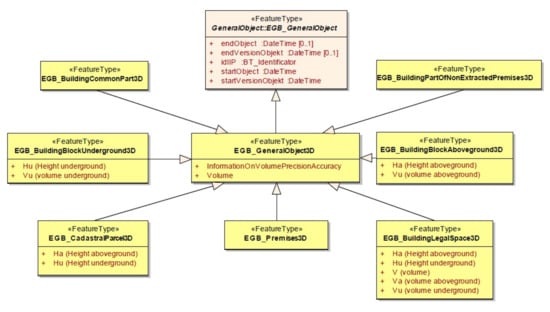
Figure 9.
Diagram of ‘GeneralObject3D’ defining the generalisation relationships between ‘EGB_GeneralObject’, ‘EGB_GeneralObject3D’ and the classes created for the proposed 3D cadastre.
The Polish cadastral model was developed more or less in parallel (although independently) with the development of the first edition of ISO 19152. In the paper [41], the classes of the Polish model were mapped according to the classes of the ‘Land Administration Domain Model’. Similarly, in the model described in this paper, the proposed new classes were assigned to the classes of the ISO 19152 reference model by mapping. The list of names of proposed new classes for the 3D cadastral model, with their names in Polish and English and the corresponding LADM classes, is presented in Table 1.

Table 1.
Proposed new classes for the 3D cadastral model, with their names in Polish and English and the corresponding Land Administration Domain Model (LADM) classes.
5. Results
The final result of this research is the Polish cadastral model for a 3D cadastre. It is presented in three UML diagrams defining a model for the proposed 3D cadastre (Figure 6, Figure 8 and Figure 9). The diagrams are prepared in the same way as the present model of the Polish 2D cadastre. The names of Diagrams 1–16 originate from the Polish cadastral model [33], and their English names are delivered from [41]. The names of Diagrams 17–19 are the result of this research. The list of diagrams is presented in Table 2.

Table 2.
Translation of diagram names in the Polish cadastral model.
To present the application of the created 3D cadastre model, a simple example of a building located in Krakow within cadastral section 92, with two premises constituting separate properties, has been chosen (Figure 10).
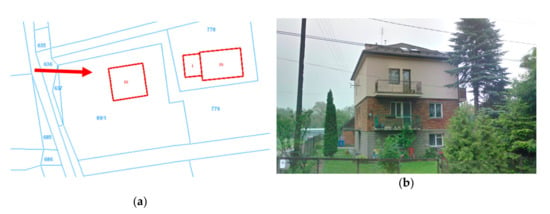
Figure 10.
Example of the building no. 89/1;1 with two separate premises constituting independent properties. (a) Building on the cadastral map; (b) photo of the building.
In building no. 89/1;1, two independent premises (89/1;1;1 and 89/1;1;2) were established. They have separate entrances and individual technical installations. Each premises occupies two floors. They can be accessed from the staircase (89/1;1;3) on Floor 1 (premises 89/1;1;1) and Floor 3 (premises 89/1;1;2). Stairs connecting Floors 1 and 2 and Floors 3 and 4 are located inside the premises. The staircase is located in the north-western corner of the building on Floors 1–3. The entrance to the building is located on the lowest floor on the northern wall.
The ownership of building no. 89/1;1 is the same as the land parcel no. 89/1, as presented in Figure 5a. Thus, the share in the ownership right in the common part of the building (staircase) and the cadastral parcel is the same. In the analysed case, the shares are 1/2 each, as sketched in Figure 11 and Figure 12.
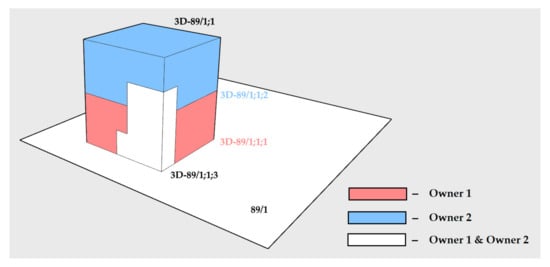
Figure 11.
Legal space of the building no. 89/1;1.
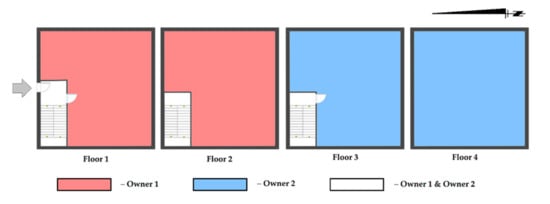
Figure 12.
Floor projections of the building no. 89/1;1.
In the proposed UML model of a future 3D cadastre in Poland, there are objects of the traditional cadastre (light brown classes) and from the proposed 3D cadastral model (yellow). In the case described above, the first are cadastral parcel no. 89/1, building no. 89/1;1 and two premises with numbers 89/1;1;1 and 89/1;1;2. The classes of the 3D cadastre are cadastral parcel 3D (3D-89/1), building (3D-89/1;1), two premises 3D (3D-89/1;1;1 and 3D-89/1;1;2) and building common part 3D (3D-89/1;1;3). The corresponding UML schema is presented in Figure 13.
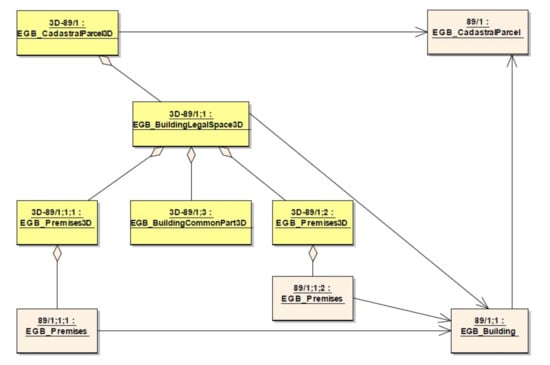
Figure 13.
UML instance schema for the analysed case.
6. Discussion and Conclusions
At present, Poland has a traditional cadastral model containing 2D objects. Progressive urbanisation causes the emergence of conflicts such as the intersection or overlapping of various types of laws, the scope of which often cannot be unambiguously defined by the legal solutions currently in force. One of the solutions, which can bring significant progress here, is the construction of a cadastral model, which will also cover the third dimension.
The development of science and technology concerning the 3D space in its broadest sense also has an impact on the perception of traditional cadastres, which in their current traditional form (2D), despite being very modern [61], are beginning to be insufficient in meeting their goals [62]. Hence, many works concerning 3D cadastres are being conducted.
The authors also believe that the proposed model may be a starting point for building a 3D cadastre in Poland. The authors are aware that a lot of organisational, legislative and technical work needs to be done to achieve this. It will include work such as defining the three proposed 3D objects in legal regulations, checking whether their definitions do not cause conflicts with other legal acts and performing pilot works, in which, among others, the 3D building model for Poland [63] should be used. After the completion of these tasks, a comprehensive assessment should be made, including an analysis of the potential profits and costs. It seems, on this basis, that it will be possible to consider a method for building a future 3D cadastre and its range. In the authors’ opinion, achieving these goals seems to be quite a distant perspective at the moment and will certainly be preceded by making many decisions, both substantive and political.
The most difficult stage in the construction of a 3D cadastre will most likely be to obtain comprehensive data on its objects in three dimensions. The cost of a completely new direct measurement of all objects that should be included in the 3D cadastre database would probably be enormous. It is also difficult to determine the time needed to obtain the full sets of data.
It seems that such a measurement will be the easiest to perform with the use of photogrammetric methods (including LIDAR). However, the authors fear that the data obtained in this way could be insufficient to create a full 3D cadastral representation of 3D objects.
Additional difficulties may be caused by direct measurements inside buildings to obtain information about 3D premises and the necessity to measure underground objects. In both cases, these objects will be described based on the measurement of their internal dimensions.
For the presented 3D cadastral model to be easy to apply, it has to be simplified as much as possible, which is why the article presents only three basic objects of the cadastre (‘Cadastral Parcels’, ‘Buildings’, and ‘Premises’) and the legal relationships between them.
The identification of shares in 3D objects, such as ‘Building Common Part 3D’, is presently based on the specification of corresponding shares in 2D. These concepts are generally based on areas (land parcel or usable building area). Authors realise that the modelling of shares in 3D can be much more complicated. It could be worth considering whether area-based shares can be used or solutions based on volumes should be applied.
Despite the fact that Chapter 4 was named ‘Creating a 3D Cadastral Model for Poland’, according to the authors, such a procedure allows the presented methodology to be applied to various legal systems, all the more so because this model can be freely modified depending on the needs of the country applying it. It can also be extended to include further classes, which will be related to, for example, spatial planning, soil quality, water ownership, ownership of mineral resources, and so forth. The forthcoming second edition of ISO 19152 ‘Land Administration Domain Model’ could also be applied.
In the authors’ opinion, the application of solutions such as IFC, CityGML or LandInfra in the Polish 3D cadastre can be considered in the future. From the research concerning these standards [7,8], we can preliminarily reason that CityGML can enrich the GML application schema of the future Polish 3D cadastre. As shown in [7], the application of LandInfra in a 3D cadastre also seems possible. As IFC is generally focused on fine-scale building and infrastructure, the possible benefits of its application in creating a 3D cadastre currently do not seem to be significant, and future research is obviously needed.
Author Contributions
Conceptualization, J.B.; methodology, J.B.; investigation, J.B. and A.B.; UML modelling, J.B.; physical objects visualisation, A.B.; writing—Original draft preparation, J.B.; writing—Review and editing, J.B. and A.B.; discussion and conclusions, J.B. and A.B. All authors have read and agreed to the published version of the manuscript.
Funding
This research received no external funding.
Acknowledgments
This work was prepared within the scope of the research funds from the AGH University of Science and Technology in Krakow.
Conflicts of Interest
The authors declare no conflict of interest.
References
- FIG Joint Commission 3 and 7 Working Group on 3D Cadastres. International Workshop on “3D Cadastres”. 28–30 November 2001. Available online: www.gdmc.nl/3DCadastres/workshop2001/ (accessed on 18 September 2020).
- Oosterom, P.; Stoter, J.; Ploeger, H.; Thompson, R.; Karki, S. World-wide inventory of the status of 3D Cadastres in 2010 and expectations for 2014. In Proceedings of the FIG Working Week, Bridging the Gap between Cultures, Marrakech, Morocco, 18–22 May 2011. [Google Scholar]
- Oosterom, P.; Stoter, J.; Ploeger, H.; Lemmen, C.; Thompson, R.; Karki, S. Initial Analysis of the Second FIG 3D Cadastres Questionnaire: Status in 2014 and Expectations for 2018. In Proceedings of the 4th International Workshop on 3D Cadastres, Dubai, UAE, 9–11 November 2014. [Google Scholar]
- Oosterom, P.; Shnaidman, A.; Rahman, A.A.; Karki, S.; Lemmen, C.; Ploeger, H. Analysis of the Third FIG 3D Cadastres Questionnaire: Status in 2018 and Expectations for 2022. In Proceedings of the FIG Working Week 2019, Geospatial Information for a Smarter Life and Environmental Resilience, Hanoi, Vietnam, 22–26 April 2019. [Google Scholar]
- FIG Joint Commission 3 and 7 Working Group on 3D Cadastres. Literature. Available online: http://www.gdmc.nl/3DCadastres/literature/ (accessed on 18 September 2020).
- ISO. Geographic Information–Land Administration Domain Model (LADM); International Organization for Standardization: Geneva, Switzerland, 2012; ISO 19152:2012. [Google Scholar]
- Gilbert, T.; Rönsdorf, C.; Plume, J.; Simmons, S.; Nisbet, N.; Gruler, H.-C.; Kolbe, T.H.; Berlo, L.; Mercer, A. Built Environment Data Standards and Their Integration: An Analysis of IFC, CityGML and LandInfra. Version 1.0, 2 March 2020, OGC Document 19-091r1, bSI TR1012. Available online: https://portal.ogc.org/files/?artifact_id=92634 (accessed on 4 November 2020).
- Kumar, K.; Labetski, A.; Ohori, K.; Ledoux, H.; Stoter, J. The LandInfra standard and its role in solving the BIM-GIS quagmire. Open Geospat. Data Softw. Stand. 2019, 4, 1–16. [Google Scholar] [CrossRef]
- Oosterom, P.; Bennet, R.; Koeva, M.; Lemmen, C. 3D Land Administration for 3D Land Uses. Land Use Policy 2020, 98, 104665. [Google Scholar] [CrossRef]
- Kalioganni, E.; Oosterom, P.; Dimopoulou, E.; Lemmen, C. 3D Land Administration: A Review and a Future Vision in the Context of the Spatial Development Lifecycle. ISPRS Int. J. Geo-Inf. 2020, 9, 107. [Google Scholar] [CrossRef]
- Griffith-Charles, C.; Sutherland, M. 3D cadastres for densely occupied informal situations: Necessity and possibility. Land Use Policy 2020, 98, 104372. [Google Scholar] [CrossRef]
- Gkeli, M.; Potsiou, C.; Ioannidis, C. A technical solution for 3D crowdsourced cadastral surveys. Land Use Policy 2020, 98, 104419. [Google Scholar] [CrossRef]
- Kalioganni, E.; Dimopoulou, E.; Thompson, R.J.; Ying, S.; Lemmen, C.; Oosterom, P. Development of 3D spatial profiles to support the full lifecycle of 3D objects. Land Use Policy 2020, 98, 104177. [Google Scholar] [CrossRef]
- Kara, A.; Oosterom, P.; Çağdaş, V.; Işıkdağ, Ü.; Lemmen, C. 3 Dimensional data research for property valuation in the context of the LADM Valuation Information Model. Land Use Policy 2020, 98, 104179. [Google Scholar] [CrossRef]
- Cemellini, B.; Thompson, R.; Oosterom, P.; Vries, M. Design, development and usability testing of an LADM compliant 3D Cadastral prototype system. Land Use Policy 2020, 98, 104418. [Google Scholar] [CrossRef]
- Indrajit, A.; Loenen, B.; Ploeger, H.; Oosterom, P. Developing a spatial planning information package in ISO 19152 land administration domain model. Land Use Policy 2020, 98, 104411. [Google Scholar] [CrossRef]
- Alattas, A.; Oosterom, P.; Zlatanova, S.; Hoeneveld, D.; Verbree, E. LADM-IndoorGML for exploring user movements in evacuation exercise. Land Use Policy 2020, 98, 104219. [Google Scholar] [CrossRef]
- Tekavec, J.; Lisec, A. Cadastral data as a source for 3D indoor modelling. Land Use Policy 2020, 98, 104322. [Google Scholar] [CrossRef]
- Tekavec, J.; Lisec, A.; Rodrigues, E. Simulating Large-Scale 3D Cadastral Dataset Using Procedural Modelling. ISPRS Int. J. Geo-Inf. 2020, 9, 598. [Google Scholar] [CrossRef]
- Ghawana, T.; Sargent, J.; Bennett, R.M.; Zevenbergen, P. 3D Cadastres in India: Examining the status and potential for land administration and management in Delhi. Land Use Policy 2020, 98, 104389. [Google Scholar] [CrossRef]
- Kitsakis, D.; Dimopoulou, E. Assessing the environmental impact of 3D public law restrictions. Land Use Policy 2020, 98, 104151. [Google Scholar] [CrossRef]
- Vučić, N.; Mađer, M.; Vranić, S.; Roić, M. Initial 3D cadastre registration by cadastral resurvey in the Republic of Croatia. Land Use Policy 2020, 98, 104335. [Google Scholar] [CrossRef]
- Larsson, K.; Paasch, J.M.; Paulsson, J. Representation of 3D cadastral boundaries – From analogue to digital. Land Use Policy 2020, 98, 104178. [Google Scholar] [CrossRef]
- Döner, F.; Sirin, S. 3D Digital Representation of Cadastral Data in Turkey—Apartments Case. Land 2020, 9, 179. [Google Scholar] [CrossRef]
- Velastegui-Cáceres, J.; Rodríguez-Espinosa, V.M.; Padilla-Almeida, O. Urban Cadastral Situation in Ecuador: Analysis to Determine the Degree of Proximity of the Cadastral Systems to the 3D Cadastral Model. Land 2020, 9, 357. [Google Scholar] [CrossRef]
- Oldfield, J.; Oosterom, P.; Quak, W.; der Veen, J.; Beetz, J. Can Data from BIMs be Used as Input for a 3D Cadastre? In Proceedings of the 5th International FIG 3D Cadastre Workshop, Athens, Greece, 18–20 October 2016; pp. 199–214. Available online: https://www.fig.net/resources/proceedings/2016/2016_3dcadastre/3Dcad_2016_21.pdf.pdf (accessed on 3 November 2020).
- Oldfield, J.; Oosterom, P.; Beetz, J.; Krijnen, T.F. Working with Open BIM Standards to Source Legal Spaces for a 3D Cadastre. ISPRS Int. J. Geo-Inf. 2017, 6, 351. [Google Scholar] [CrossRef]
- Sun, J.; Mi, S.; Olsson, P.; Paulsson, J.; Harrie, L. Utilizing BIM and GIS for Representation and Visualization of 3D Cadastre. ISPRS Int. J. Geo-Inf. 2019, 8, 503. [Google Scholar] [CrossRef]
- Sladić, D.; Radulović, A.; Govedarica, M. Development of process model for Serbian cadastre. Land Use Policy 2020, 98, 104273. [Google Scholar] [CrossRef]
- Asghari, A.; Kalantari, M.; Rajabifard, A. A structured framework for 3D cadastral data validation − a case study for Victoria, Australia. Land Use Policy 2020, 98, 104359. [Google Scholar] [CrossRef]
- Alberdi, R.; Erba, D.A. Modeling Legal Land Object for waterbodies in the context of 4D cadastre. Land Use Policy 2020, 98, 104417. [Google Scholar] [CrossRef]
- Sejm of the Republic of Poland. Act of 17 May 1989—Law on Geodesy and Cartography (Journal of Laws No. 30, Item 163, as Amended). Available online: http://isap.sejm.gov.pl/isap.nsf/download.xsp/WDU19890300163/U/D19890163Lj.pdf (accessed on 21 September 2020).
- Sejm of the Republic of Poland. Regulation of Ministry of Administration and Digitization from 29th of March 2001 Concerning the Land and Building Cadastre—Consolidated Text (Journal of Laws from 2016, Item 1034). Available online: http://isap.sejm.gov.pl/isap.nsf/download.xsp/WDU20160001034/O/D20161034.pdf (accessed on 21 September 2020).
- Przewięźlikowska, A. Legal aspects of synchronising data on real property location in polish cadastre and land and mortgage register. Land Use Policy 2020, 95, 104606. [Google Scholar] [CrossRef]
- Sejm of the Republic of Poland. Act of 6 July 1982—Land Register and Mortgage (Journal of Laws No. 19, Item 147, as Amended). Available online: http://isap.sejm.gov.pl/isap.nsf/download.xsp/WDU20180001916/U/D20181916Lj.pdf (accessed on 21 September 2020).
- Dawidowicz, A.; Klimach, A.; Źróbek, R. Dynamics of Legal Changes in Polish Cadastre. In Dynamics in GIscience; Lecture Notes in Geoinformation and Cartography; Ivan, I., Horák, J., Inspektor, T., Eds.; Springer: Cham, Switzerland, 2018. [Google Scholar] [CrossRef]
- Maślanka, J. Entering Parcel Boundaries into the Polish Register of Land and Buildings—An Analysis of the Current State and Proposed Changes. Geomat. Environ. Eng. 2020, 14, 63–87. [Google Scholar] [CrossRef]
- Directive 2007/2/EC of The European Parliament and of the Council of 14 March 2007 Establishing an Infrastructure for Spatial Information in the European Community (INSPIRE). Available online: http://eur-lex.europa.eu/legal-content/EN/TXT/?uri=CELEX:32007L0002 (accessed on 21 September 2020).
- Sejm of the Republic of Poland. Act of 4 March 2010 on Spatial Information Infrastructure (Journal of Laws from 2010, No. 76, Item 489, as Ameded). Available online: http://isap.sejm.gov.pl/isap.nsf/download.xsp/WDU20100760489/U/D20100489Lj.pdf (accessed on 21 September 2020).
- Sejm of the Republic of Poland. Regulation of Ministry of Administration and Digitization from 29th of November 2013 Changing the Regulation on Land and Building Cadastre (Journal of Laws from 2013, Item 1551). Available online: http://isap.sejm.gov.pl/isap.nsf/download.xsp/WDU20130001551/O/D20131551.pdf (accessed on 21 September 2020).
- Bydłosz, J. The application of the Land Administration Domain Model in building a country profile for the Polish cadastre. Land Use Policy 2015, 49, 598–605. [Google Scholar] [CrossRef]
- Puniach, E.; Bieda, A.; Ćwiąkała, P.; Kwartnik-Pruc, A.; Parzych, P. Use of unmanned aerial vehicles (UAVs) for updating farmland cadastral data in areas subject to landslides. ISPRS Int. J. Geo-Inf. 2018, 7, 331. [Google Scholar] [CrossRef]
- Questionnaire 3D-Cadastres: Status November 2010 Poland. Available online: www.gdmc.nl/3DCadastres/participants/3D_Cadastres_Poland.pdf (accessed on 21 September 2020).
- Questionnaire 3D-Cadastres: Status September 2014 Poland. Available online: http://www.gdmc.nl/3DCadastres/participants/3D_Cadastres_Poland2014.pdf (accessed on 21 September 2020).
- 3rd Questionnaire 3D-Cadastres: Status December 2018 Poland. Available online: http://www.gdmc.nl/3DCadastres/participants/3D_Cadastres_Poland2018.pdf (accessed on 21 September 2020).
- Siejka, M.; Ślusarski, M.; Zygmunt, M. 3D + time Cadastre, possibility of implementation in Poland. Surv. Rev. 2014, 46, 79–89. [Google Scholar] [CrossRef]
- Karabin, M. A Concept of a Model Approach to the 3D Cadastre in Poland: Technical and Legal Aspects. In Proceedings of the 4th International Workshop on 3D Cadastres, Dubai, UAE, 9–11 November 2014. [Google Scholar]
- Góźdź, K.; Pachelski, W.; Oosterom, P.; Coors, V. The Possibilities of Using CityGML for 3D Representation of Buildings in the Cadastre. In Proceedings of the 4th International Workshop on 3D Cadastres, Dubai, UAE, 9–11 November 2014. [Google Scholar]
- Bydłosz, J. Modelowanie informacji katastralnej (Modelling of cadastral information). In Modelowanie Informacji Geograficznej Dla Potrzeb Budowy Infrastruktury Informacji Przestrzennej; Bielecka, E., Pachelski, W., Eds.; Wojskowa Akademia Techniczna: Warszawa, Poland, 2014; pp. 19–35. [Google Scholar]
- Bydłosz, J. Developing the Polish Cadastral Model Towards 3D Cadastre. In Proceedings of the 5th International FIG 3D Cadastre Workshop, Athens, Greece, 18–20 October 2016; pp. 505–518. Available online: Fig.net/resources/proceedings/2016/2016_3dcadastre/3Dcad_2016_38.pdf.pdf (accessed on 25 September 2020).
- Bydłosz, J.; Bieda, A.; Parzych, P. The Implementation of Spatial Planning Objects in a 3D Cadastral Model. ISPRS Int. J. Geo-Inf. 2018, 7, 153. [Google Scholar] [CrossRef]
- Karabin, M.; Kitsakis, D.; Koeva, M.; Navratil, G.; Paasch, J.; Paulsson, J.; Vučić, N.; Janečka, K.; Lisec, A. Layer Approach to Ownership in 3D Cadastre—A Subway Case. In Proceedings of the 6th International Workshop on 3D Cadastres, Delft, The Netherlands, 2–4 October 2018; pp. 111–136. [Google Scholar]
- Karabin, M. Rules concerned Registration of the Spatial Objects in Poland in the Context of 3D Cadastre’s Requirements. In Proceedings of the 2nd International Workshop on 3D Cadastres, Delft, the Netherlands, 16–18 November 2011; pp. 433–452. [Google Scholar]
- Karabin, M.; Bakuła, K.; Fijałkowska, A.; Karabin-Zych, M. Feasibility study of 3D cadastre implementation using various data sources—The case of Warsaw Subway. Geod. Vestn. 2018, 3, 445–457. [Google Scholar] [CrossRef]
- Bydłosz, J. The cadastre in Poland—The Current Status and Possibilities of Transformation into 3D One. In Proceedings of the FIG Working Week 2012: Knowing to Manage the Territory, Protect the Environment, Evaluate the Cultural Heritage, Rome, Italy, 6–10 May 2012; pp. 1–9. Available online: http://www.gdmc.nl/3dcadastres/literature/3Dcad_2012_11.pdf (accessed on 21 September 2020).
- Bieda, A.; Bydłosz, J.; Warchoł, A.; Balawejder, M. Historical Underground Structures as 3D Cadastral Objects. Remote Sens. 2020, 12, 1547. [Google Scholar] [CrossRef]
- Head Office of Geodesy and Cartography. Regulation of Ministry of Administration and Digitization from 29th of November 2013 (with Later Changes)—Application Schemas. Available online: http://www.gugik.gov.pl/bip/prawo/schematy-aplikacyjne/rozporzadzenie-ministra-administracji-i-cyfryzacji-z-dnia-6-listopada-2015-r.-zmieniajace-rozporzadzenie-w-sprawie-ewidencji-gruntow-i-budynkow (accessed on 22 September 2020).
- Bydłosz, J. Przyszłe obiekty katastru 3D w Polsce—Future objects of 3D cadastre in Poland. Acta Sci. Pol. Adm. Locorum 2017, 16, 231–237. [Google Scholar]
- Regulation of the Council of Ministers of 30 December 1999 on the Polish Classification of Construction Objects (PCCO). Journal of Laws from 1999, No. 112, Item 1316. Available online: http://isap.sejm.gov.pl/isap.nsf/DocDetails.xsp?id=WDU19991121316 (accessed on 21 September 2020).
- Sejm of the Republic of Poland. Act of 24 June 1994 on the Ownership of Premises—Consolidated Text. Journal of Laws from 2020, Item 532. Available online: https://isap.sejm.gov.pl/isap.nsf/download.xsp/WDU20200000532/U/D20200532Lj.pdf (accessed on 22 September 2020).
- Dawidowicz, A.; Zysk, E.; Źróbek, R. A Methodological Evaluation of the Polish Land Administration System Using the Fit for Purpose Approach. Geomat. Environ. Eng. 2020, 14, 31–47. [Google Scholar] [CrossRef]
- Kwiecień, J.; Krajewska, M.; Szopińska, K. Design and Implementation of a Spatial Database for the Analysis of Residential Estate Market. In Proceedings of the Geographic Information Systems Conference and Exhibition “GIS Odyssey 2018”—Conference Proceedings, Perugia, Italy, 10–14 September 2018; pp. 328–333. [Google Scholar]
- Geoportal 3D. Available online: https://mapy.geoportal.gov.pl/imap/Imgp_2.html?gpmap=imap3d (accessed on 25 September 2020).
Publisher’s Note: MDPI stays neutral with regard to jurisdictional claims in published maps and institutional affiliations. |
© 2020 by the authors. Licensee MDPI, Basel, Switzerland. This article is an open access article distributed under the terms and conditions of the Creative Commons Attribution (CC BY) license (http://creativecommons.org/licenses/by/4.0/).